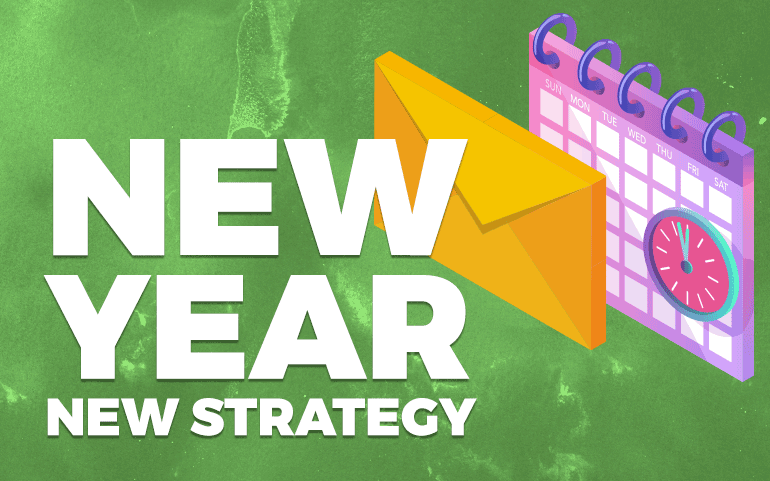Happy New Year!
It’s officially 2019, and there’s never been a better time to be in ecommerce. Sales across our industry continue to steadily increase, and it looks like another banner year for online retail. With that being said, ecommerce businesses will face bigger competition this year. It’s more important than ever to improve your email remarketing strategy.
In “Looking Back at Your Annual Metrics,” we went over several indicators of issues within your sales funnel. This time around, we want to show you solutions for those problems so you can start your new year with a bang.
Here are ways to improve your email remarketing strategy in the new year.
Fixing Low Open Rates
As we previously discussed in 2018, open rates are the most vital and basic statistic in email remarketing. If you consistently find that your messages are being opened less than 20% of the time, you have two main options for fixing this.
-
Improve Your Header
When a customer receives an email from you, your first priority should be your open rate. If the recipient doesn’t read the message, nothing else matters.
Why are headers so important? They largely determine whether or not your message will be opened. A good header must be:
-Short enough to be read in its entirety
-Concise enough to communicate the value proposition
-Interesting enough to make them want to know more
Another idea currently in vogue is the use of emojis in subject lines. While these can help your email stand out, they can also get your message sent directly to the spam folder. The prevailing opinion at the moment is to use them like fats-oils-and-sweets: sparingly. While they can breathe life into a boring header, they can easily become obnoxious if overused.
-
Rewrite Your Sender Names
The sender name is always visible and often overlooked. Users read their inboxes from left-to-right, first scanning the sender name and then the subject line. According to Campaign Monitor, 68% of Americans base their decision to open an email on the sender name.
When determining your business’s sender name, multiple factors should be considered. ‘5 Sender Names to Increase Email Open Rates’ offers suggestions on how to optimize this opportunity.
-
Change Your Email Frequency
We’ve talked before about the problem of sending too many or too few emails. While every company is different, sending one or more emails every single day can quickly wear out an audience.
It doesn’t matter how incredible your new arrivals are – if you’re contacting your list every day, people are going to get worn out. It is almost always better to err on the side of sending too few. The fewer you send, the more likely someone is to see your communications as valuable. Learn to optimize the frequency of your remarketing emails.
Improving Click Through/Click-to-Open Rates
Click Through and Click-to-Open rates measure the same thing in a different way. A click through rate measures what percentage of recipients clicked on a link within the message overall. The Click-to-Open expresses this number as a percent of those who actually opened the email. For example, imagine an email was sent to 10 people; 4 people read, and 1 clicked. The click through rate would be 10%, while the Click-to-Open rate would be 25%.
If your open rate is solid but your click through rate is not, the problem likely lies within the copy or graphics of the email. While every company is different, there are couple of general guidelines that can help improve these rates.
-
Improve Your CTAs
Calls to Action are the backbone of a successful campaign. To be effective, they must convey precisely what you want the reader to do in as few words as possible. Ideally, they should contain no more than 2-3 words. For example, if the email is alerting customers of a clothing sale, “Shop New Styles” or “Shop Now” work well. However, “Shop New Looks and Styles From Brand X Now” doesn’t work, since the copy should have already conveyed much of that information.
In addition, every email should include at least two CTAs: one in the beginning, and one towards the end. If the reader is interested from the message’s onset, the reader doesn’t have to bother with the rest of the body copy and can immediately initiate. If the reader wants more information, they don’t have to find the CTA all over again at the top.
-
Keep it Short
Everyone is busy. Research shows that marketing emails get significantly less attention than personal ones. Thus, you should never be sending them an essay to read.
At most, the email should have 3 paragraphs: a short intro, several sentences of body copy, and a short conclusion. Additionally, this is not an English paper. By no means should your paragraphs be made up of “about 5 sentences.” In general, 5-7 sentences should make up the entirety of the email. This gives your email the greatest chance of being read in its entirety.
Conclusion
Good email strategy can be summed up in two words: “short” and “sweet.” Email is not, by nature, a high engagement platform. However, by refining our efforts, we can consistently reach consumers effectively in ways that other mediums cannot.
By optimizing your email remarketing strategy, you can increase your open rates and ultimately increase conversions.
To ensure you are effectively reaching customers, use our guide ’27 Attributes of an Effective Email.’ This comprehensive guide was created to help ecommerce professionals write persuasive emails that convert.
